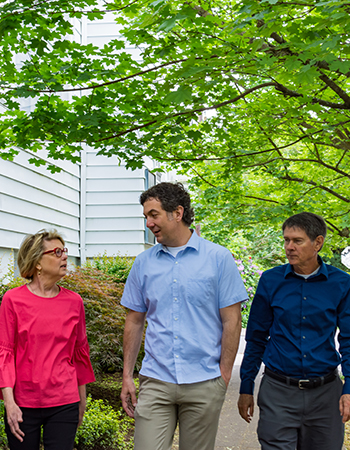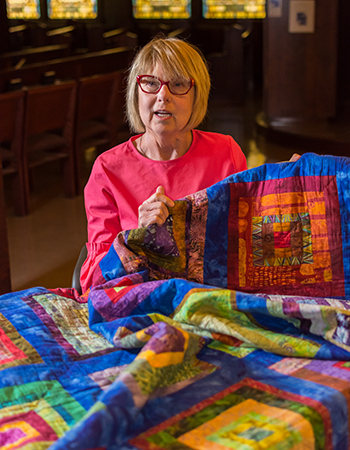Kidney donors gave from the heart
Gifts help two others lead healthier lives

Harold Nussbaum donated one of his kidneys to someone he doesn’t know and probably will never meet. So did Kyle Roy. They both attend Portland (Oregon) Mennonite Church.
It all started when Harold’s friend, Elaine Gammell, was ill and needed a kidney.
“I have a friend who was sick,” Harold said. “I made a decision to see if I could help her.”
Sounds simple enough, but it wasn’t. Elaine’s situation was complicated, and it turned out that Harold’s kidney could not become hers. Kyle’s kidney wasn’t a match for her either.
Elaine went to a hospital in 2014 with an illness doctors had a hard time diagnosing. “I was having trouble breathing and didn’t want to eat anything,” she said.
She was in the hospital for a month. She went home knowing she has atypical hemolytic uremic syndrome, also referred to as aHUS, a rare disease that often causes kidney failure.
Elaine’s name joined a list of people needing transplants because her kidneys weren’t functioning.
Hoping to help Elaine, Harold got his first blood tests in April 2015 to become a potential donor.
Explaining the need at church
About two months later, “I stood up in church during the time when we share our concerns,” Harold said. Elaine and her husband, Tim, had attended Portland Mennonite but no longer did when Harold spoke to the congregation.
Harold said, “Many in the congregation already knew that Elaine had these health difficulties. I told them Elaine needed a kidney and I wasn’t a match, but maybe someone else could be.”
A kidney donor for Elaine needed to have Type O blood as a starting point, he explained to his fellow worshippers that Sunday.
“A young man approached me after the service and said he was interested in being a donor,” Harold said. That young man was Kyle, who didn’t know Elaine and Tim because their attendance at Portland Mennonite didn’t overlap.
“It was one of those strange coincidences” when Harold got up in church and talked about the need for kidneys, Kyle said.
Kyle’s wife, Linnea, had a partner in her medical practice who experienced kidney failure, and another doctor was a match. Kyle recently had read a Peter Singer book called The most good you can do, which mentions kidney donations. And Kyle has Type O blood.
Forging ahead anyway
Kyle soon learned his kidneys weren’t a match for Elaine. Even so, “I decided I’m just going to do this anyway,” he said. “I decided to leave it up to God as to who got my kidney.”
Kyle’s kidney was removed in April 2016 at Oregon Health & Science University Hospital. Harold’s was removed in August 2016 in the same hospital.
Elaine Gammell, Kyle Roy and Harold Nussbaum walk outside Portland Mennonite Church.
By the time Kyle and Harold had their donation surgeries, Elaine had a new kidney. Her transplant surgery took place in November 2015 at OHSU.
A transplant for Elaine was anything but a sure thing. Finding a suitable donor kidney was problematic in several ways, including the fact that Elaine’s body contained so many antibodies. Antibodies attack foreign tissue, such as a new kidney.
“I’d had plasma from over 300 people during plasma therapy treatment for aHUS,” she said, “so I had lots of antibodies.”
30 minutes to decide
In spite of the complications, a donor kidney that looked like a good match became available. It was from someone dying of brain cancer, but the cancer appeared to be contained in the brain.
A nurse called Elaine to tell her about the source of the donor kidney. Time was of the essence, so “she told me to think about it and she’d call again in 30 minutes. She did, and I said I wanted it. They have a wonderful team at OHSU.”
Elaine feels much better since the transplant. “It completely changes your life,” she said.
Before the transplant, Elaine devoted four hours to dialysis every Monday, Wednesday and Friday, plus travel time. Dialysis cleans the blood but doesn’t accomplish as much as a healthy kidney.
Food didn’t taste good and fluids were limited to 32 ounces per day. “I had little energy, lots of nausea and spent a lot of time sleeping,” she said.
After the transplant, Elaine’s still on medication for aHUS, but “I can eat and drink just about anything I desire now,” she said. “I began to cook again and can enjoy eating with family and friends.” Her mind is clearer and she has more energy.
Playing with the grandkids
Elaine and Tim live in Vancouver, Washington, across the Columbia River from Portland. Elaine said, “I can now spend time with my grandchildren, play with them, babysit to help out our daughters here in Vancouver.”
Elaine has known Harold for years, and she was eager to meet Kyle. She and Tim arranged to get together with Kyle for coffee. “Kyle was amazing,” Elaine said. “He had a very scientific way of looking at everything.”
Kyle’s approach led him to examine the odds of potential complications related to donating a kidney.
Elaine Gammell holds a quilt that youngsters sit on during children's time in the church.
Kyle weighed the possibility of falling while climbing and damaging his remaining kidney.
He also wondered, “What if someone I know and love needs a kidney later, and I already gave one? All of those fears were certainly there.”
Kyle and Linnea have two sons – one is almost 5 years old and one is almost 2.
Looking at the situation logically, he realized there’s a slim chance that a family member will need a kidney transplant. There’s no history of kidney disease or diabetes in Kyle’s family.
“And there’s a 100 percent chance that this person needs my kidney,” Kyle said.
Elaine, other recipients grateful
Elaine said she’ll be forever grateful and honored that Harold and Kyle wanted to give her a kidney. “That is a selfless act of love.”
The two donors got thank-you notes from the people who received their kidneys, but the recipients remain anonymous.
Harold’s note said, “You’re giving me a new lease on life and I plan on making the best of it.” Harold hasn’t heard anything more. “I just hope they’re doing well,” he said.
Kyle’s note said, “May you find peace knowing you’ve given me many more days of life.”